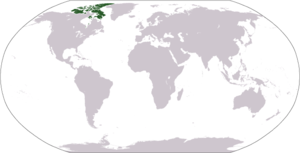Arctic Archipelago



The Canadian Arctic Archipelago, also known as just the Arctic Archipelago, is an archipelago north of the Canadian mainland in the Arctic. Situated in the northern extremity of North America and covering about 1 424 500 km², this group of 36 563 islands comprises much of the territory of Northern Canada – most of Nunavut and part of Northwest Territories.
The archipelago extends some 2 400 km longitudinally and 1 900 km from the mainland to Cape Columbia, the northernmost point on Ellesmere Island. It is bounded on the west by the Beaufort Sea; on the north by the Arctic Ocean; on the east by Greenland, Baffin Bay and Davis Strait; and on the south by Hudson Bay and the Canadian mainland. The various islands are separated from each other and the continental mainland by a series of waterways collectively known as the Northwestern Passages. Two large peninsulas, Boothia and Melville, extend northward from the mainland.
The archipelago contains 94 major islands (greater than 130 km²), including three of the world's ten largest islands, and 36 469 minor islands. The sizeable islands of the archipelago (over 10 000 km², in order of descending size) are:
| Name | Location* | Area (km²) |
Area rank | Population (2001) | |
|---|---|---|---|---|---|
| World | Canada | ||||
| Baffin Island | 507 451 | 5 | 1 | 9 563 | |
| Victoria Island | 217 291 | 9 | 2 | 1 707 | |
| Ellesmere Island | 196 236 | 10 | 3 | 168 | |
| Banks Island | 70 028 | 24 | 5 | 114 | |
| Devon Island | 55 247 | 27 | 6 | 0 | |
| Axel Heiberg Island | 43 178 | 32 | 7 | 0 | |
| Melville Island | 42 149 | 33 | 8 | 0 | |
| Southampton Island | 41 214 | 34 | 9 | 721 | |
| Prince of Wales Island | 33 339 | 40 | 10 | 0 | |
| Somerset Island | 24 786 | 46 | 12 | 0 | |
| Bathurst Island | 16 042 | 54 | 13 | 0 | |
| Prince Patrick Island | 15 848 | 55 | 14 | 0 | |
| King William Island | 13 111 | 61 | 15 | 960 | |
| Ellef Ringnes Island | 11 295 | 69 | 16 | 0 | |
| Bylot Island | 11 067 | 72 | 17 | 0 | |
* NT = Northwest Territories, NU = Nunavut
After Greenland, the archipelago is the world’s largest high-arctic land area. The climate of the islands is arctic, and the terrain consists of tundra except in mountainous areas. Most of the islands are uninhabited; human settlement is extremely thin and scattered, being mainly coastal Inuit settlements on the southern islands.
British claims on the islands were based on the explorations in the 1570s by Martin Frobisher. Canadian sovereignty over them was not established until the District of Franklin was established in 1895, which comprised almost all of the archipelago; the district was dissolved upon the creation of Nunavut in 1999. Canada claims sovereignty in a sector continuing to the North Pole, a claim that is not universally recognized. In addition, Canada claims all the waterways of the Northwestern Passages as internal waters; however the United States and some other countries view these as international waters. Disagreement over the passages' status has raised Canadian concerns about environmental enforcement, national security, and general sovereignty. Hans Island, in the Nares Strait east of Ellesmere Island, is a territory currently contested between Canada and Denmark.
References
Marsh, James H., ed. 1988. "Arctic Archipelago" The Canadian Encyclopedia. Toronto: Hurtig Publishers.
